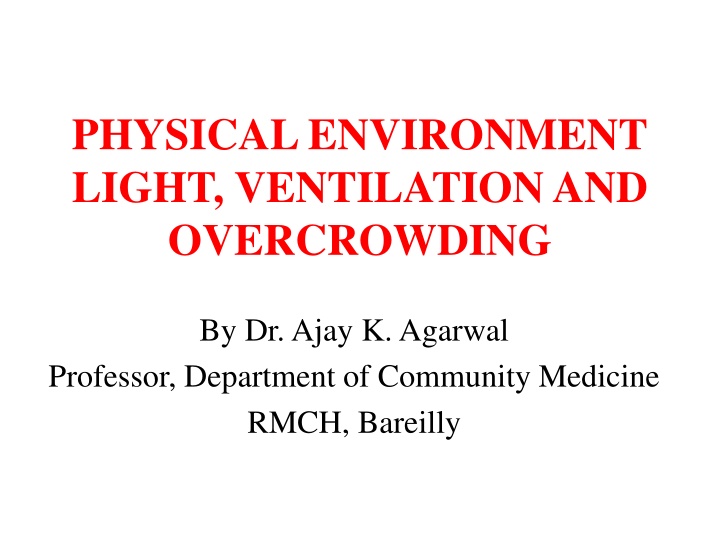
Importance of Light and Ventilation in the Physical Environment
Learn about the significance of light and ventilation in creating a conducive physical environment. Explore the characteristics of light, sources of light, and the impact of natural and artificial light on human vision and productivity. Discover the measurement of light and factors for efficient work under proper lighting conditions.
Download Presentation

Please find below an Image/Link to download the presentation.
The content on the website is provided AS IS for your information and personal use only. It may not be sold, licensed, or shared on other websites without obtaining consent from the author. If you encounter any issues during the download, it is possible that the publisher has removed the file from their server.
You are allowed to download the files provided on this website for personal or commercial use, subject to the condition that they are used lawfully. All files are the property of their respective owners.
The content on the website is provided AS IS for your information and personal use only. It may not be sold, licensed, or shared on other websites without obtaining consent from the author.
E N D
Presentation Transcript
PHYSICAL ENVIRONMENT LIGHT, VENTILATION AND OVERCROWDING By Dr. Ajay K. Agarwal Professor, Department of Community Medicine RMCH, Bareilly
Light is electromagnetic radiation within a certain portion of the electromagnetic spectrum. The word usually refers to visible light, which is visible to the human eye and is responsible for the sense of sight. Visible light is usually defined as having wavelengths in the range of 400 700 nanometres (nm), between the infrared (with longer wavelengths) and the ultraviolet (with shorter wavelengths).
LIGHT Essential for vision. SOURCES OF LIGHT: Natural source Artificial source
NATURAL SOURCE: Natural source is sun. Visible rays of sunlight constitute solar spectrum. Sunrays beyond spectrum are invisible. Rays beyond violet end are ultraviolet rays and rays beyond red end are infrared rays
DAY LIGHT FACTOR FOR CARRYING OUT WORK EFFICIENTLY WITH EFFICIENT VISION: Sufficient illumination of 15-20 foot candles Uniform distribution in working place. Absence of glare (glare is excessive contrast) Absence of sharp shadows Steadiness of source of light White color of light Contrast surroundings
MEASUREMENT OF LIGHT CANDLE: Amount of light given off by burning of spermwax candle burning 120 grain per hour is called 1 candle power. Illumination received from one candle at a distance of one foot, is known as one foot candle. Measured by instrument photometer.
Light also measured Luminous flux (flow of light) expressed in lumens. Illumination (amount of light reaching a surface) expressed as lux per unit area. Luminance (brightness i.e. amount of light refracted from a surface ) expressed as lamberts.
LIGHT MEASUREMENT UNITS Description Quantity measured name Luminous intensity Luminous flux Illumination Illuminance Recommended units* Candela Other units 1. Brightness of point source 2. Flow of light 3. Amount of light reaching surface 4. Amount of light re-emitted by surface Candle power Lumen Lux Foot candle Lumen /cm2 (Phot) Foot lambert Candles /cm2 Brightness Luminance Lambert * Recommended by the International Organization for Standardization
NATURAL LIGHTING Obtained not only from sky but also from refraction. Efficient utilization calls careful design, location, orientation of building and relationship between buildings. Depends upon time of the day, season weather and atmospheric pollution.
MEASURES TO IMPROVE NATURAL LIGHTING: Building should be directed towards North and South, so that there should be uniform lighting from morning to evening. Construction of windows must be properly planned. A tall narrow window gives greater penetration of light and broad window gives greater diffusion of light. Inside the rooms ceiling should be white, the upper portion of walls should be light colored and lower portion should be slightly dark.
MEASUREMENT OF DAYLIGHT Measured in DAYLIGHT FACTOR (D.F.) : Ratio of illumination in a given point to illumination at a point exposed simultaneously to the whole hemisphere of sky (taken as 500 foot candles) excluding direct sunlight. D.F.= Instantaneous illumination INDOORS X 100 Simultaneously occurring illumination OUTDOORS May be determined by Day Light Factor Meter. D.F. in rooms should be at least 8% and 10% in kitchen.
ARTIFICIAL LIGHTING Electric lighting-as no combustion nor any reduction in oxygen content of atmosphere. Gives good, steady and bright light. DIFFERENT TYPES OF ELECTRIC LIGHTS: FILAMENT LAMPS: Tungsten filament is heated and light is emitted. Only 5% for light rest 95% expended as heat.
FLUORESCENT LAMPS (VAPOR LAMPS): Neon filled sodium discharge lamp: Gives yellow light. MERCURY VAPOR LAMP: Glass tube filled with mercury vapor and electrode fitted at each end. Inside is coated with fluorescent chemicals which absorbs ultraviolet radiations
COLD CATHODE NEON LAMPS: Used for decorative purpose. SHADOW LESS LIGHT: Especially necessary in operation theaters.
LIGHTING STANDARDS Eyes responds to a range of illumination from 0.1 lux (full moonlight night) to 100,000 lux (bright sunshine). Visual efficacy increase with increase of illumination, but the curve flatten out at higher levels.. Rule of thumb is that illumination level should be 30 times higher than the level at which task can be just done.
RECOMMENDED ILLUMINATION (IES CODE) Visual task Illumination (lux) Casual reading 100 General office work 400 Fine assembly 900 Very severe task 1,300-2000 Watch making 2,000-3,000
BIOLOGICAL EFFECTS OF LIGHT Daylight could cause in vitro degradation of bilirubin now being used as a therapeutic measure in premature infants with hyper- bilirubinaemia. Biologic rhythms of body temperature, physical activity, the stimulation of melanin synthesis, the activation of precursors of vitamin D, adrenocortical secretion and food consumption.
VENTILATION Replacement of vitiated air (stagnant, warm and moist air) by drier, cooler and moving air but also control of quality of incoming air. Internal and external ventilation. INTERNAL VENTILATION-ventilation of rooms. EXTERNAL VENTILATION-by making street broad, building houses with sufficient gap in between and to sufficient height, watering the street to lay the dust, by keeping plenty of open spaces and parks etc.
FRESH AIR SUPPLY De Chaumont recommended 3000 cu. Feet/hour/person. Stuffiness occur in room when CO2 concentration exceeds 0.02%. Amount of fresh air d=e p d= amount of fresh air to be delivered to a room. e = CO2 exhaled /hour/person ( a person at rest gives off 0.6 cu.ft of CO2/hour p= limit of respiratory CO2/cu.ft. of air(i.e. 0.02 cu.ft/100 cu.ft of air, i.e. 0.0002 in one cu.ft.)
d= 0.6 = 3000 0.0002 AIR CHANGE: For a person occupying room of 100 cu.ft the air should be changed 30 times/hour or if occupied 1000 cu.ft room require air change 3 times /hour. FLOOR AREA: Optimum floor area /person in a house is 50-100 sq.ft.
SYSTEMS OF VENTILATION 1. Natural 2. Artificial NATURAL VENTILATION: a. Perflation and aspiration of the wind b. Difference of temperature c. Diffusion of gases
If buildings are constructed with sufficient open space around and by having large number of windows preferably opening direct outside. Cross ventilation means perflation between windows and other opening placed opposite to each other.
PERFLATION AND ASPIRATION OF THE WIND: Blowing of air through a room, when doors and windows are open.
EFFECTS OF DIFFERENCE OF TEMPERATURE: Air always flows from high density to low density. Outer cooler air is of high density, inside air of room being of lower density. Greater the difference of temperature, greater will be velocity of incoming air.
DIFFUSION OF GASES: Passing of gases through smallest opening or spaces. Very slow and very small so as a ventilating agent , of little value.
ARTIFICIAL VENTILATION (MECHANICAL VENTILATION) 1. Vacuum system 2. Plenum system 3. Balanced system 4. Air conditioning
1. VACUUM SYSTEM (EXHAUST OR EXTRACTION SYSTEM): Fowl vitiated air is extracted or exhausted to the outside by using exhaust fan, so vacuum is created and fresh air enters in.
PLENUM SYSTEM (PROPELLER SYSTEM): Fresh air is pushed into the room by centrifugal fans or high pressure fans. Create a positive pressure and displaces vitiated air.
BALANCED SYSTEM: Combination of both exhaust system and plenum system
AIR CONDITIONING: Outer air is conditioned or controlled with reference to physical and chemical conditions- Cleaning free from pathogens dirt and dust, adjustment of temperature-cool or warm, adjustment of humidity and at a measured rate and volume without producing draught.
Overcrowding Overcrowding: Overcrowding refers to the situation in which more people are living within a single dwelling than there is space for, so that movement is restricted, privacy secluded, hygiene impossible, rest and sleep difficult
OVERCROWDING CONT.. OVERCROWDING (1) PERSONS PER ROOM 1 room 2 persons 2 rooms 3 persons 3 rooms 5 persons 4 rooms - 7 persons 5 or more rooms 10 persons (additional 2 for each further room)
OVERCROWDING CONT.. (2) FLOOR SPACE: 1. The accepted standards are: 2. 110 sq.ft. or more - 2 persons 3. 90-100 sq.ft. 1 1/2 persons 4. 70-90 sq.ft. - 1 person 5. 50-70 sq.ft. - 1/2 person 6. Under 50 sq.ft nil (A baby under 12 months is not counted; children between 1 to 10 counted as half a unit).
OVERCROWDING CONT.. SEX SEPERATION: Overcrowding is considered to exist if 2 persons over 9 years of age, not husband and wife, of opposite sexes are obliged to sleep in the same room.
NOISE INTRODUCTION: Unwanted sound, causing disturbance or annoyance. MEASURABLE PROPERTIES: 1. frequency 2. Intensity
FREQUENCY: Number of complete vibration cycles per second. Measured in units Hertz (Hz) One Hz = one wave/second. Determines pitch of sound. Normal human audio frequency range 20- 20000 Hz Below 20 Hz infra-sounds Above 20,000 Hz are ultra-sounds
160 Mechanic damage 150 Threshold of pain 140 130 120 Motor car horn Train passing station 110 100 Recommended maximum ( 85 db) 90 Printing press Heavy street traffic Normal conversation 80 70 60 50 Quiet library 40 30 whispering 20 10 Community noise level
INTENSITY: Amplitude of vibrations. Measured in Decibels (dB) Recorded in noise meter
NOISE LEVEL VALUES Whispering -20-30dB Normal conversion -30-65 dB Street traffic -60-80 dB Shouting -About 100 dB Motor car horn, boiler factories -About 120 dB Train, aero plane engine -About 120 dB Threshold of pain -About 140 dB Jet plane -About 150 dB Mechanical damage -About 150-160 dB
INSTRUMENTS USED IN THE STUDY OF NOISE SOUND LEVEL METER: Measures the intensity of sound in decibel (dB) OCTAVE BAND FREQUENCY ANALYZER: Indicates that frequency high pitched or low pitched. AUDIOMETER: Measures hearing ability. Zero line at top of audiogram represents normal hearing.
Noise pollution or noise disturbance is the disturbing or excessive noise that may harm the activity or balance of human or animal life.


